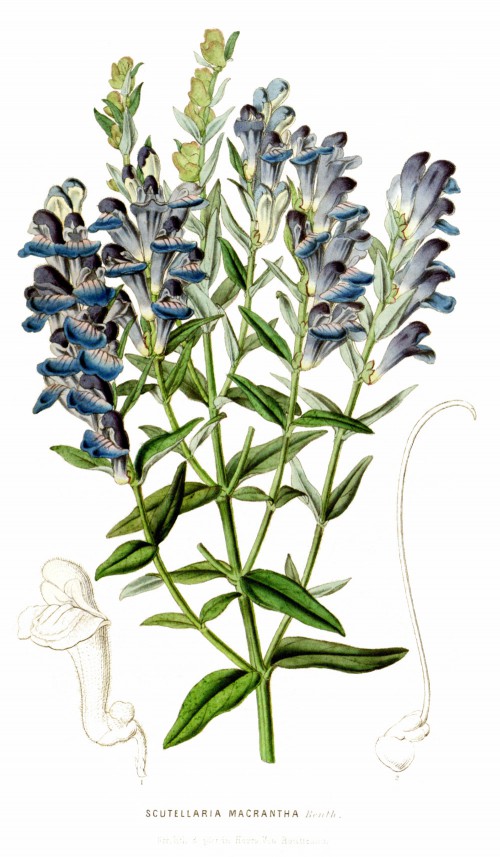Scutellaria baicalensis Georgi - syn. Scutellaria macrantha Fisch. - Lamiaceae
黄芩 huang qin (chin.), Baical skullcap, Baikal-Helmkraut, Chinesisches Helmkraut
Perennial herb, up to 120cm tall, native to Mongolia, China, Korea, Russia, also cultivated; leaves lanceolate to linear-lanceolate, to 4.5cm long, abaxially densely impressed glandular, entire; flowers in terminal racemes, corolla purple-red to blue, 2-3cm, densely glandular pubescent outside. „Traditionally used as a febrifuge, for relieving fever, and diminishing inflammation. This is one of the most commonly collected species in China.“ http://www.efloras.org/florataxon.aspx?flora_id=2&taxon_id=200020285
„Scutellaria baicalensis is one of the most popular and multi-purpose herb used in China traditionally for treatment of inflammation, hypertension, cardiovascular diseases, and bacterial and viral infections. Accumulating evidence demonstrate that Scutellaria also possesses potent anticancer activities. The bioactive components of Scutellaria have been confirmed to be flavones. The major constituents of Scutellaria baicalensis are Wogonin, Baicalein and Baicalin. These phytochemicals are not only cytostatic but also cytotoxic to various human tumor cell lines in vitro and inhibit tumor growth in vivo. Most importantly, they show almost no or minor toxicity to normal epithelial and normal peripheral blood and myeloid cells. The antitumor functions of these flavones are largely due to their abilities to scavenge oxidative radicals, to attenuate NF-κB activity, to inhibit several genes important for regulation of the cell cycle, to suppress COX-2 gene expression and to prevent viral infections. The tumor-selectivity of Wogonin has recently been demonstrated to be due to its ability to differentially modulate the oxidation-reduction status of malignant vs. normal lymphocytic cells and to preferentially induce phospholipase Cγ1, a key enzyme involved in Ca2+ signaling, through H2O2 signaling in malignant lymphocytes.“
[New therapeutic aspects of flavones: The anticancer properties of Scutellaria and its main active constituents Wogonin, Baicalein and Baicalin., Li-Weber, M., Cancer Treatment Reviews, 35(1), 2009, 57-68]
„Six flavones are proven to be the major bioactive flavones in Radix Scutellariae existing in the forms of aglycones (baicalein, wogonin, oroxylin A) and glycosides (baicalin, wogonoside, oroxylin A-7-glucuronide). All six flavones are pharmacologically active and show great potential in the treatment of inflammation, cancers and virus-related diseases.“
[Pharmacological effects and pharmacokinetics properties of Radix Scutellariae and its bioactive flavones., Li, C., Lin, G., Zuo, Z., Biopharmaceutics & drug disposition, 32(8), 2011, 427-445] http://onlinelibrary.wiley.com/doi/10.1002/bdd.771/full

S.baicalensis as Scutellaria macrantha Fischer ex Rchb.; Houtte,L. van, Flore des serres et des jardin de l’Europe, vol.5 p.428 (1849)
http://plantgenera.org/species.php?id_species=926467